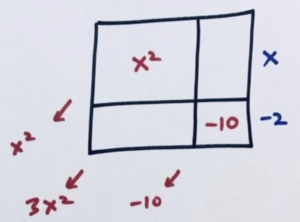Quadratics
4.3 Practice, The Difference of Two Squares (again), The Difference and Sum of Two Cubes
Lesson materials located below the video overview.
SETTING THE SCENE
Recall the practice of the Factor Theorem.
PROBLEM: Consider the quadratic expression \(x^2+3x-10\).
a) Show that putting in \(x=2\)makes this expression zero.
b) Show that \(x-2\) is a factor of \(x^2+3x-10\).
Answer: a) We have \((2)^2+3(2)-10=0\), as hoped.
b) By the Factor Theorem, it must be the case then that \(x-2\) is a factor of the quadratic expression.
If we wish to actually find the other factor, we can draw an unsymmetrical rectangle with the information we have and deduce its other side length to be \(x+5\).

Or we can perform our sneaky algebra.
\(x^2+3x-10=x\left(x-2\right)+2x+3x-10\)
\(=x\left(x-2\right)+5x-10\)
\(=x\left(x-2\right)+5\left(x-2\right)+10-10\)
\(=x\left(x-2\right)+5\left(x-2\right)\)
We see \(x^2+3x-10=\left(x+5\right)\left(x-2\right)\).
Let’s now apply the Factor Theorem to deduce classic mathematics formulas.
READ MORE HERE: QUADRATICS PD Essay 4.3
(See too Edfinity.com/XXX for a robust source of curriculum practice problems for you collate, organise, and use.)
Resources
Books
Take your understanding to the next level with easy to understand books by James Tanton.
BROWSE BOOKS![]()
Guides & Solutions
Dive deeper into key topics through detailed, easy to follow guides and solution sets.
BROWSE GUIDES![]()
Donations
Consider supporting G'Day Math! with a donation, of any amount.
Your support is so much appreciated and enables the continued creation of great course content. Thanks!
Ready to Help?
Donations can be made via PayPal and major credit cards. A PayPal account is not required. Many thanks!
DONATE![]()


